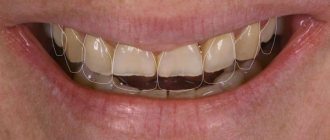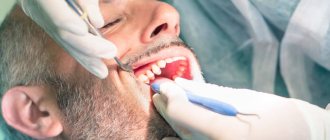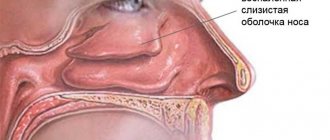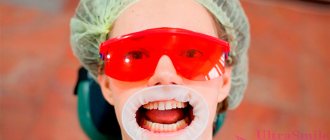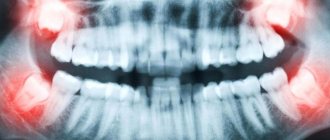Modern methods of professional teeth cleaning are safe and comfortable for the patient. The procedure can be performed even during pregnancy.
Complex cleaning is practically painless; in very rare cases, anesthesia is required. Removal of hard dental deposits and soft plaque is carried out in several stages:
- Tartar removal. First, all hard dental deposits are removed. The procedure is carried out using ultrasound.
- Cleansing using the Air Flow device. Under the influence of water pressure containing abrasive particles, tooth enamel is not only cleaned of soft plaque, but also whitened to its natural shade.
- Polishing. After brushing, the surface of the teeth becomes slightly rough, which will contribute to the rapid accumulation of plaque. To avoid this, the tooth surface is treated with special discs and bristles. After the procedure, the enamel becomes smooth and protected from the effects of pathogenic microflora.
- Treatment with antiseptics. To prevent the spread of infection and to prevent gum inflammation, the oral cavity is treated with an antiseptic solution.
- Fluoridation. After cleaning, the teeth are coated with fluoride varnish to strengthen and reduce the sensitivity of the enamel.
- Applying therapeutic bandages. In case of severe gum inflammation and periodontal bleeding, special therapeutic dressings are applied. The dressings may contain antiseptics, antiviral drugs, and antibiotics.
Inflammation after cleaning
The main cause of inflammation is increased sensitivity of teeth and gums. Increased sensitivity may be an individual characteristic of the patient's body, or it may be a consequence of gum pathologies such as gingivitis, periodontitis or periodontal disease. Sometimes the cause of discomfort can be deep tartar, the removal of which caused inflammation. If you follow all the hygienist’s recommendations, the discomfort will disappear within a few hours after the procedure.
Also, the causes of inflammation after brushing can be an incorrectly selected toothbrush and toothpaste, as well as injury to soft tissues due to careless brushing of teeth. That is why it is very important to follow all the specialist’s recommendations. After brushing the teeth, the hygienist shows the patient how to brush their teeth properly. In addition, the doctor selects a brush, paste, dental floss and additional oral care products that are suitable for the patient.
Why do dental deposits form?
- The abundance of phosphates in saliva due to metabolic disorders.
- Irregular cleaning of the oral cavity, lack of knowledge of proper hygiene, lack of attention to the interdental space.
- Low-quality hygiene products: toothpastes, rinses and brushes from unscrupulous manufacturers who only promise a therapeutic effect.
- Poor heredity is a genetic predisposition to the formation of dental plaque.
- Excessive amount of soft food in your menu. During active chewing, natural plaque removal occurs.
- Dietary and other habits: regular consumption of tea and coffee drinks, smoking leads to darkening of the enamel and the deposition of sediment on the surface of the tooth.
Rehabilitation after the procedure
To prevent gum inflammation from starting after the procedure, and for the results to last for a long time, the patient is required to properly care for the oral cavity.
What is required from the patient:
- Do not consume coloring foods and drinks for the first 24 hours after the procedure. These products include: colored fruits, vegetables and berries, coffee, red wine and natural juices.
- Immediately after the procedure, do not drink too hot or cold drinks.
- Immediately after brushing, replace the old toothbrush with a new one.
- Not only use a toothbrush twice a day, but also use dental floss and irrigator at least once a day.
- Be sure to visit your dentist every six months for a routine preventive examination.
- Do not neglect professional teeth cleaning, undergo the procedure regularly according to the indications of a specialist. As a rule, doctors recommend undergoing a comprehensive cleaning twice a year.
General recommendations
After professional hygiene, tooth enamel becomes thinner and requires at least two weeks to restore. In addition, when removing hard plaque, the gums suffer, and the degree of trauma depends on their initial condition. For successful rehabilitation and consolidation of the results obtained, dentists at the Atlantis Dental clinic recommend adhering to a set of measures.
- It is necessary to use a toothbrush with soft bristles, as well as a toothpaste with an abrasiveness index (RDA) from 30 to 50 and a high content of minerals - calcium, fluoride, etc.
- After each meal, the mouth is rinsed with a solution that does not contain alcohol, for example, Miramistin or Chlorhexidine. Despite the fact that ethanol is a powerful antiseptic, it irritates and dries the injured mucous membrane. This effect leads to inflammation and pain.
- For rapid tissue regeneration, relief of hyperemia and bleeding of the gums, it is recommended to apply anti-inflammatory gels to the gums two to three times a day. The most effective drug is Metrogyl Denta.
- The use of herbal infusions is excluded, since they contain coloring pigments and intensely stain tooth enamel.
- Hygienic procedures are carried out at least twice a day. Irrigators, dental brushes and floss are used to clean the interdental spaces.
- In some cases, the doctor may prescribe painkillers and anti-inflammatory drugs.
For maximum effect from the procedure, regular visits to a hygienist are required - at least twice a year. Particular attention should be paid to maintaining a healthy lifestyle and choosing care products.
The appointment includes consultation and drawing up a treatment plan with cost determination
sign up for a free consultation
Not ready for an in-person consultation with a doctor? Ask your question by phone
You must refrain from any food or drinks for an hour after the procedure. If remineralization therapy was carried out, the time increases several times. The first meal may include:
- soups without tomato;
- dairy products;
- casseroles;
- boiled beef, poultry, fish;
- porridge;
- bananas;
- vegetables after heat treatment.
During the recovery period, which takes two to three weeks, you should avoid foods with natural or artificial colors. Gradually, fresh fruits and vegetables are introduced into the diet: apples, pears, carrots, cabbage.
Plant products with a solid structure prevent plaque formation and put stress on bone tissue, which improves blood circulation.
What should you not eat after brushing your teeth?
In the first days after the procedure, consuming products with coloring pigments can cause darkening of the enamel. The following should be excluded from the diet:
- tea, coffee and other drinks with dyes;
- spices (turmeric, mustard, paprika, etc.);
- chocolate, cocoa;
- red berries (cherries, blackberries, blueberries);
- beets, carrots, cabbage.
Drinks and dishes should not be very hot or cold, and you should not eat sour, spicy or too salty foods.
Caffeinated drinks - to drink or not to drink?
Tea and coffee contain tannins and coloring agents that give tooth enamel a yellow-brown tint. Therefore, after professional hygiene, you should completely exclude such products from your diet for several weeks. If necessary, drinks can be diluted with milk or water and consumed through a straw.
Is it possible to smoke?
The habit is especially harmful after professional teeth cleaning.
Resins accumulate on the enamel and around the neck of the crown, forming mineral deposits and contributing to the development of caries. Hot smoke irritates injured mucous tissues, causing bleeding gums and aggravating the inflammatory process. We strongly recommend that you avoid cigarettes, pipes, hookahs and vapes for the first 5-7 days after treatment! It is during this time that the enamel is restored and covered with a protective layer.
Alcohol is prohibited
Some types of alcohol contain dyes, so you should limit your consumption:
- cocktails;
- red wine;
- chilled beer;
- energy drinks and tonics.
Clear or light-colored drinks are allowed, but after drinking them, you must thoroughly rinse your mouth.
Advantages and disadvantages of ultrasonic teeth cleaning
Ultrasonic teeth cleaning is an excellent prevention not only of caries, but also of diseases such as periodontitis, periodontal disease, gingivitis and stomatitis. Ultrasonic cleaning not only effectively removes all types of plaque, but also destroys pathogenic microflora in the oral cavity. The technique is universal and suitable for patients of all ages.
Other benefits of ultrasonic cleaning include:
- Delicacy and safety. Ultrasonic cleaning allows you to clean dental surfaces without damaging the enamel or injuring the gums;
- The ability to remove deposits in the most inaccessible areas of the oral cavity. Only ultrasonic cleaning will effectively remove plaque in the space under the gums;
- Sterilizing ability: ultrasound destroys bacteria;
- Ultrasonic cleaning helps get rid of bad breath and lighten the enamel to its natural color.
Tartar formation
There are two ways to accumulate solid plaque, depending on the location of its accumulation:
- Above the gums. Formed as a result of the activity of pathogenic organisms. It is easy to notice when a person smiles. The edges of the teeth appear darker or have a yellow tint. Often it is localized on the inside. In this case, it is more difficult to detect the problem.
- Under the gums. At first glance, the teeth look healthy. But if you pay attention to the mucous membrane, it appears bluish. Swelling and bleeding may occur. A stone located between the gum and the root of the tooth can lead to the formation of local suppuration.
Typically, such dental deposits are noticed by a specialist during a routine examination. Only an experienced dental hygienist can detect and eliminate this problem.
How is tartar removed?
Mechanical cleaning is a relic of the past. Today there are safe and painless methods of combating soft plaque and tartar.
Ultrasonic cleaning
Contrary to the popular stereotype, ultrasonic cleaning does not harm the protective enamel. An ultrasonic scaler is one of the most effective ways to remove tartar. Oscillations and vibrations at a certain frequency break deposits into tiny particles, which are subsequently removed from the oral cavity by an air-water jet. During the procedure, there is no direct interaction between the device attachment and the gums.
Manipulation is contraindicated for patients whose teeth are significantly affected by deep caries. At the same time, the procedure is indicated as a preparatory stage for a number of serious operations.
Professional teeth cleaning for pregnant women
Pregnancy is an important stage in the fate of a woman and her baby. The expectant mother wants to look attractive, but does not agree to put the baby’s health at risk for this. It is not surprising that pregnant women are constantly wondering whether the event will harm the baby?
There is no danger to the fetus, this is a recommended measure for pregnant women, the gynecologist will approve it.
A pregnant woman's body undergoes a powerful restructuring, in which the teeth also participate - their condition changes dramatically. The enamel becomes thinner, the tooth becomes vulnerable to the slightest infection. The procedure, performed competently and professionally, will protect the teeth by reducing the number of bacteria in the mouth. It is safe for the fetus and the pregnant woman, does not affect the systems and organs. No medications are used during the procedure, which is fundamentally important for pregnant women.
Temperature after dental treatment
There are cases when the temperature rises after dental treatment. Don't be afraid of it, because it is essentially our body's immune response to physiological or emotional stress. And this does not always indicate poor-quality dental services.
Causes
Among the reasons that cause an increase in temperature after dental treatment are:
- the complexity of the dental procedures performed (for example, removal of a wisdom tooth, implantation, surgical treatment of a cyst are difficult medical procedures);
- strong psycho-emotional experiences (the patient’s well-being during treatment and the course of the recovery process largely depend on the level of stress);
- tissue inflammation as a result of mechanical injury or penetration of an infectious agent;
- violation of post-procedure medical recommendations (if you rinse your mouth earlier than 2 hours after tooth extraction, there is a high probability of washing out the blood clot and suppuration of the hole, which will be accompanied by severe paroxysmal pain).
When should you see a doctor?
Temperature after dental treatment may be normal, especially after surgical procedures. With a slight increase, you should not knock it down. This will give your body the opportunity to recover faster. But if you see a figure above 38 degrees on the thermometer, it’s worth thinking about an antipyretic drug.
You should see a doctor if:
- body temperature stays above 38 degrees for more than 2 days and does not drop;
- Severe swelling has formed at the site of dental procedures and the mucous membrane has become inflamed;
- you experience severe pain that gradually or rapidly increases;
- your lymph nodes in your neck have become enlarged.
In this case, you will be prescribed an x-ray, based on the results of which it will be possible to judge the boundaries of the spread of the inflammatory process and the condition of the tissues involved in it. Based on the data obtained and the collected history, a diagnosis will be made and symptomatic treatment will be prescribed.
In any case, if you have a fever, you are not feeling well and you are worried that you are experiencing complications after dental treatment, it is better to consult your doctor again. After all, disease prevention is the key to oral health.
Read more:
- What to do after tooth extraction?
- Why does a tooth hurt after extraction?
How is ultrasonic teeth cleaning performed?
During the examination, the dentist assesses the condition of the teeth in general, the volume and places of accumulation of hard deposits. Some can be located on the visible part of the teeth and under the gums, while others can only be identified using special equipment. If deep cleaning is required, or the patient has increased sensitivity of tooth enamel, then local anesthesia is used.
The procedure is carried out with an ultrasonic scaler and includes several stages:
- cleaning the visible part of the teeth;
- removing stone along the gums;
- cleaning pockets under the gums;
- grinding the surface of teeth with professional micro-abrasive pastes and attachments to eliminate roughness from destroyed formations; polishing makes the tooth surface smoother and makes it more difficult for plaque to accumulate on the teeth;
- To strengthen the enamel, your dentist may recommend a fluoride coating. Fluoridation after ultrasonic cleansing gives the maximum effect, as the absorbency of the enamel increases.
Different modes of operation of the device make it possible to carry out cleansing using liquids or the dry method. The liquid may be water or, if necessary, the dentist may recommend anti-inflammatory agents or antiseptics. The simultaneous supply of ultrasonic vibrations and liquid causes the appearance of microscopic bubbles, which help soften and separate hard dental deposits from the enamel.
